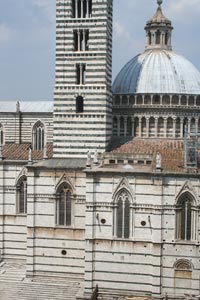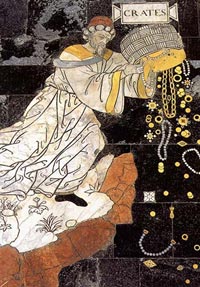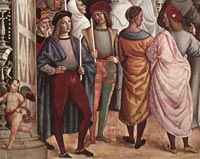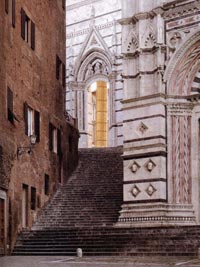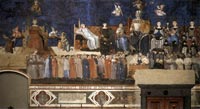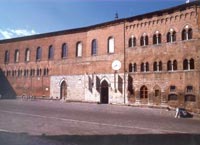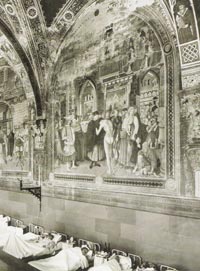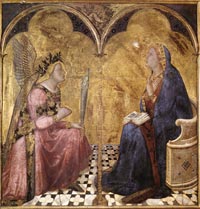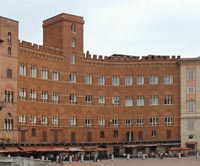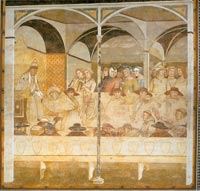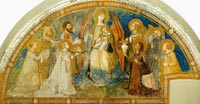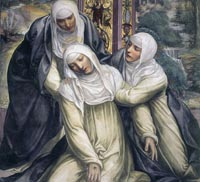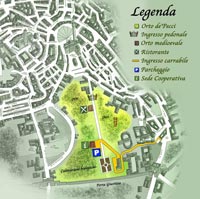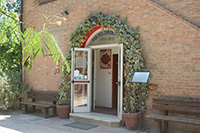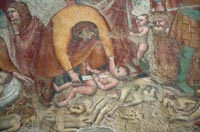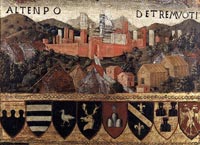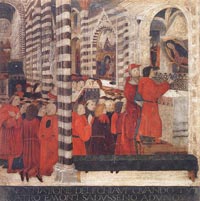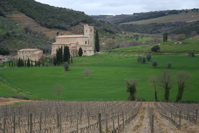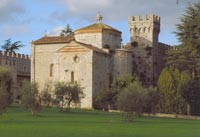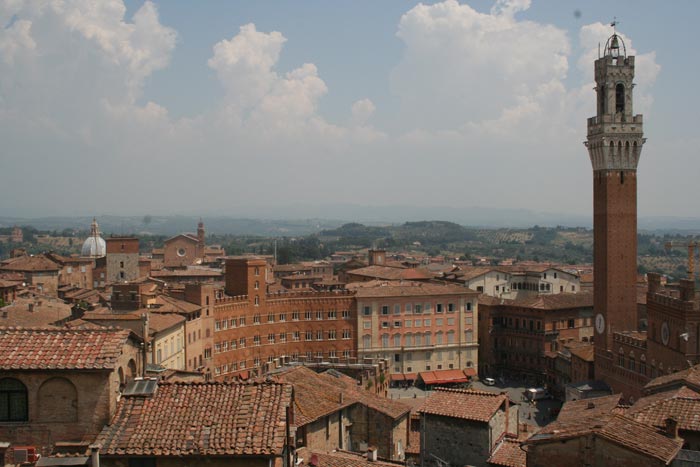 |
Siena, Piazza Il Campo |
More than many other Italian cities, Siena is a world in its own right, where the historical past is always present and inescapable, and is cyclically renewed in the annual ritual of the Palio, the focus of the city’s structure, the passion and even the identity of its people. Italo Calvino |
|
Built on three hills and surrounded by a magnificent territory, Siena is one of the most beautiful cities in the world; recognized for the quality of its monuments, it has managed to conserve its essence and its mediaeval appearance. From the beginning, Siena has been a distinctively original city, to the point that, as a whole, it can be considered to be the largest surviving medieval complex in Europe.
|
|||
There are innumerable restaurants, trattorie and osterie in Siena, as well as wineries, pasticcerie and food markets. We selected some of the best cultural restaurants in Siena, and wine cellars, where a selection of some of the best Tuscan wines is kept. The best food addresses in Siena
|
|||
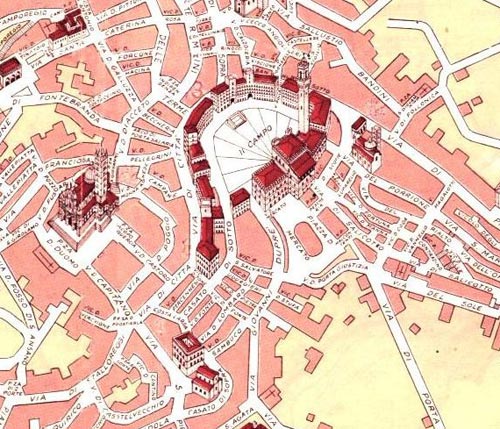 |
|||
Piazza del Campo
|
|||
Fonte Gaia
|
|||
| The Fonte Gaia fountain, designed by Jacopo della Quercia (ca. 1367–1438). around 1419, is the main fountain in the city of Siena, situated onthe highest part of Piazza del Campo. The original panels were the work of Jacopo della Quercia. Badly deteriorated by long exposure to the elements, the fountain was entirely replaced in 1868 by a copy made by neo-Renaissance sculptor Tito Sarrocchi (1824–1900). The side reliefs depict episodes from Genesis: The Creation of Adam and The Flight from the Garden of Eden. Visual evidence indicates that Sarrocchi's revival sculpture, currently in situ, cannot be considered a copy of Quercia's Fonte Gaia, but rather a variant of it.[1] The originalsculptures by Jacopo della Quercia are now in the Ospedale Santa Maria della Scala. |
 |
||
Fonte Gaia
|
|||
The Palio
|
|||
| Twice a year the Italian city of Siena goes crazy for the oldest horse race in the world: the Palio, ahistoric contest that takes place twice a year in the Siena's exquisitely beautiful main square, the Piazza del Campo. Horses are allocated by lot four days prior to the race. Get schedules, tips, videos, histories and more here. Palio, Cosima Spender's vivid film follows a season of the famous bareback horse race around the Piazza del Campo in Siena. Information and trailer here. |
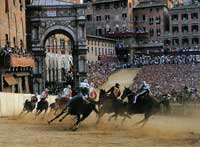 |
||
|
Il Palio di Siena | Photo Gallery Il Palio di Siena | The World's Most Exciting Horse Race | Some of the most exciting Palios |
|
||
|
|||
| The cathedral, dedicated to Assunta, was originally designed and completed between 1215 and 1263 on the site of an earlier structure. it took the form in the XIII and XIV centuries, while the roman and gothic periods were interwoven: this last clarity in the facade is in part due to Giovanni Pisano. The cathedral contains valuable pieces of art including The Feast of Herod by Donatello, and works by Bernini and the young Michelangelo. It makes this cathedral an extraordinary museum of Italian sculpture. Many of the Duomo's original furnishings, such as Duccio di Buoninsegna's Maestà and Cimabue's stained glass window, have been removed to the nearby Museo del Opera del Duomo. The floor is completely inlaid with pictorial pavings, inlaid with different colored marbles, to startlingly realistic effect, most of which are covered to protect them. [read more | The Siena Duomo |
 |
||
| Mosaic floor |
|||
| The inlaid marble mosaic floor is one of the most ornate of its kind in Italy, covering the whole floor of the cathedral. This undertaking went on for two centuries (14th-16th c.) and about forty artists made their contribution. The floor consists of 56 panels in different sizes. Most have a rectangular shape, but the later ones in the transept are hexagons or rhombuses. They represent the sibyls, scenes from the Old Testament, allegories and virtues. Most are still in their original state. The earliest scenes were made by a graffito technique : drilling tiny holes and scratching lines in the marble and filling these with bitumen or mineral pitch. In a later stage black, white, green, red and blue marble intarsia were used. This technique of marble inlay also evolved during the years, finally resulting in a vigorous contrast of light and dark, giving it an almost modern, impressionistic composition.
The uncovered floor can only be seen during three weeks each year. The rest of the year, they are covered and only a few are on display. The Story of Fortuna, or Hill of Virtue (Allegoria della Fortuna), by Pinturicchio in 1504, was the last one commissioned by Aringhieri. This panel also gives a depiction of Socrates. The earliest panel was probably the Wheel of Fortune (Ruota della Fortuna), laid in 1372 (restored in 1864). The She-Wolf of Siena with the emblems of the confederate cities (Lupa senese e simboli delle città alleate) probably dates from 1373 (also restored in 1864). The Four Virtues (Temperanza, Prudenza, Giustizia and Fortezza) and Mercy (Misericordia) date from 1406, as established by a payment made to Marchese d'Adamo and his fellow workers. They ware the craftsmen who executed the cartoons of Sienese painters. The first known artist, working on the panels, was Domenico di Niccolò dei Cori, who was in charge of the cathedral between 1413 and 1423. We can ascribe to him several panels such as the Story of King David, David the Psalmist and David and Goliath. His successor as superintendent, Paolo di Martino, completed between 1424 and 1426 the Victory of Joshua and Victory of Samson over the Philistines. In 1434 the renowned painter Domenico di Bartolo continued with a new panel Emperor Sigismund Enthroned (Imperatore Sigismundo in trono). The Holy Roman Emperor Sigismund had stayed during ten months in Siena on his way to Rome for his coronation. This panel is proof of his popularity by the Sienese. Next to this panel, is the composition in 1447 (probably) by Pietro di Tommaso del Minella of the Death of Absolom (Morte di Assalonne). The next panel dates from 1473 : Stories from the Life of Judith and the Liberation of Bethulia (Liberazione di Betulia) (probably) by Urbano da Cortona. In 1480 Alberto Aringhieri was appointed superintendent of the works. From then on, the mosaic floor scheme began to make serious progress. Between 1481 and 1483 the ten panels of the Sibyls were worked out. A few are ascribed to eminent artists, such as Matteo di Giovanni (the Samian Sibyl), Neroccio di Bartolomea (Hellespontine Sibyl) and Benvenuto di Giovanni (Albunenan Sibyl). The Cumaean, Delphic, Persian and Phrygian Sibyls are from the hand of the obscure German artist Vito di Marco. The Erythraean Sibyl was originally by Antonio Federighi, the Libyan Sibyl by the painter Guidoccio Cozzarelli, but both have been extensively renovated. The large panel in the transept The Slaughter of the Innocents (Strage degli Innocenti) is probably the work of Matteo di Giovanni in 1481. The large panel below, the Expulsion of Herod (Cacciata di Erode), was designed by Benvenuto di Giovanni in 1484-1485. The Story of Fortuna, or Hill of Virtue (Allegoria della Fortuna), by Pinturicchio in 1504, was the last one commissioned by Aringhieri. This panel also gives a depiction of Socrates. Domenico Beccafumi, the most renowned Sienese artist of his time, worked on the floor during thirty years (1518-1547). Half of the thirteen Scenes from the Life of Elijah, in the transept of the cathedral, were designed by him (two hexagons and two rhombuses). The eight meter long frieze Moses Striking water from the Rock was executed by him in 1525. The bordering panel, Moses on Mount Sinai was laid in 1531. His final contribution was the panel in front of the main altar : the Sacrifice of Isaac (1547). |
|
||
| Piccolomini Library |
|||
| Adjoining the cathedral is the Piccolomini library, housing precious illuminated choir books and frescoes painted by the Umbrian Bernardino di betto, called Pinturicchio, probably based on designs by Raphael. The Piccolomini altar, left of the entrance to the library, is the work of the Lombard sculptor Andrea Bregno in 1483. This altarpiece is remarkable because of the four sculptures in the lower niches, made by the young Michelangelo between 1501 and 1504 : Saint Peter, Saint Paul, Saint Gregory (with the help of an assistant) and Saint Pius. On top of the altar is the Madonna and Child, a sculpture (probably) by Jacopo della Quercia. The frescoes tell the story of the life of Siena's favourite son, cardinal Enea Silvio Piccolomini, who eventually became Pope Pius II. Pinturicchio painted this cycle of frescoes around the library between 1502 and 1507, representing Rafael and himself in several of them. This masterpiece is full of striking detail and vivacious colours. The visual impact of these very colourful frescoes is stunning. Pinturicchio's fresco cycle is a rare example of a unified decoration of the early sixteenth century. Well-suited to Pinturicchio's skills and to a somewhat provincial Siena, his lyric style fits comfortably into the medieval setting of the Cathedral. [read more] |
|
||
| The baptistry is located underneath the eastern bays of the choir of the Duomo. Unlike Florence or Pisa, Siena did not build a separate baptistry.The construction of the interior was largely performed under Camaino di Crescentino and was completed about 1325 [3]. It is rectangular in shape, divided in three aisles. The frescoes on the vaults were painted by Lorenzo di Pietro (also called Vecchietta) between 1447 and 1450. They represent the Articles of Faith, Prophets and Sibyls. Unfortunately, these valuable frescoes were repainted at the end of the 19th c. He also painted two scenes on the wall of the apse: Flagellation and Road to Calvary. Lichele di Matteo da Bologna painted in 1477 the frescoes on the vault of the apse. Cripta
|
|
||
|
|||
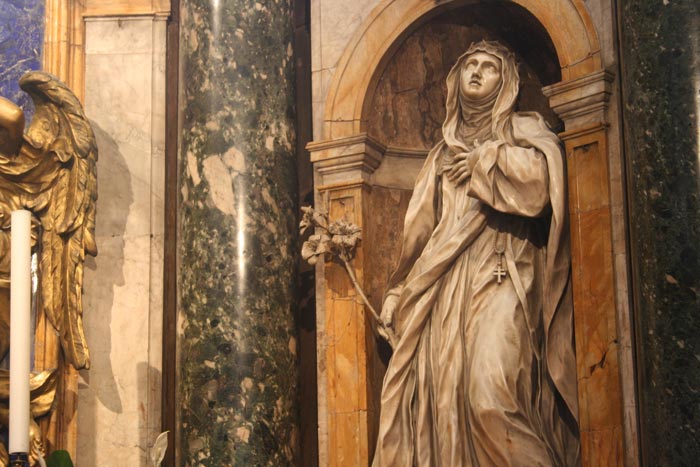 |
|||
Bernini's Chapel, in the Siena Cathedral
|
|||
| Romulus and Remus |
|||
| Black and white are the symbolic colors of Siena. Next to the façade stands a column with the she-wolf breast-feeding Romulus and Remus, symbol of Siena (and also of the contrade Lupa). According to legend, Senius and Aschius, sons of Remus, founded Siena. They had stolen the statue of the she-wolf from the Temple of Apollo in Rome. The symbolic colors of the city derive as well from these two legendary founders--Aschius rode a black horse and Senius rode a white one. | 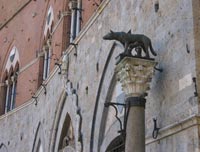 The emblem of Siena: a she-wolf suckling the infants Romulus and Remus. |
||
| Palazzo Pubblico |
|||
| The construction of the Palazzo Pubblico demonstrated an intense commitment during a relatively short period (1297-1308) that resulted in one of the most elegant and functional buildings of all time, notable for its harmonious, almost symbiotic, relationship with its surroundings. The Palazzo Pubblico has always represented the centre of civic life for the citizens of Siena; it has frequently been at the centre of the most significant events in the history of the city. The outside of the structure is an example of Italian medieval architecture with Gothic influences. The lower story is stone; the upper crenelatted stories are made of brick. The facade of the palace is curved slightly inwards (concave) to reflect the outwards curve (convex) of the Piazza del Campo, Siena's central square of which the Palace is the focal point. The campanile or bell tower, Torre del Mangia, was built between 1325 and 1344 with its crown designed by the painter, Lippo Memmi. The tower was designed to be taller than the tower in neighboring rival Florence; at the time it was the tallest structure in Italy. |
|||
| The decorations that testify to the wisdom and taste of the new governing class of the city were entrusted to the most important Maestri of Sienan art. Nearly every major room in the palace contains frescoes. The most famous of the secular frescoes are three panels in the series on government in the Hall of the Nine (also known as Sala della Pace) by Ambrogio Lorenzetti. These frescoes are collectively known as Allegory and Effects of Good and Bad Government. [1] |
|||
| Other notable frescoes include the mysterious fresco of Guidoriccio da Fogliano at the siege of Montemassi, located in the Great Council Hall (Sala del Mappamondo). The end wall of the Sala del Mappamondo, opposite to the wall containing Simone's Maestà, is entirely covered by this fresco depicting the famous commander Guidoriccio with defeated fortresses in the background. The fresco is traditionally attributed to Simone Martini, although there is debate on the subject. |
|||
Accompanying Simone Martini's Maestà in the Sala del Mappamondo (formerly known as Sala del Consiglio) were a number of secular images. Frescoes commemorated battles and important military captains. One of the best surviving examples of this reportorial art was commissioned from the painter and miniaturist Lippo Vanni to record the Sienese victory in the Val di Chiana over English mercenaries in 1363. His monochromatic fresco records the progress of the battle and the disposition of the troops episodically across the wall; it is a graphic chronicle of the event rather than a naturalistic reconstruction, with cities carefully labeled and the armies identified by the heraldic flags of their leaders. |
|||
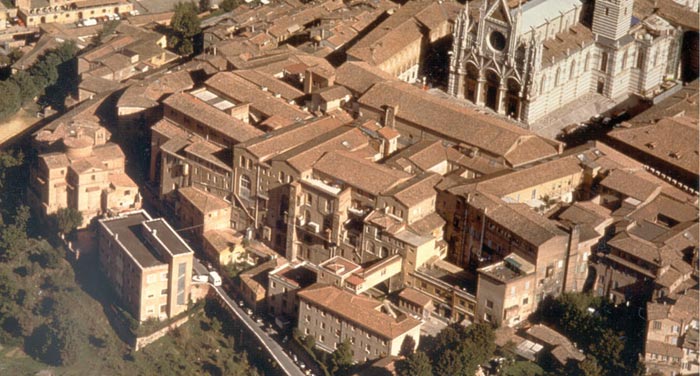 |
|||
Ospedale Santa Maria della Scala |
|||
| The Medieval hospital complex, very interesting for its architecture and decorations, is adorned with frescoes by Domenico di Bartolo, Priamo di Pietro della Quercia and Lorenzo Vecchietta. Especially notable are the pieces in precious metals and ceramics from the X to the XVI century. The Ospedale di Santa Maria della Scala, one of Europe’s oldest hospitals, is situated in front of the Duomo. Ospedale di Santa Maria della Scala takes its name from the steps, scala, leading up to the cathedral. Santa Maria della Scala terminated its health-service functions some years ago and became (and in part still is) the object of an important renovation operation for museum and cultural purposes. This large complex, located in the heart of Siena, conserves extraordinarily intact testimonials of thousands of years of history. The hospital was founded by the Cathedral's priests across the Via Francigena to house the pilgrims coming from France and northern Europe to Rome. In the 15th century it became under the responsibility of the city's commune, receiving numerous donations from the local wealthiest families. It also received important artistic works: these include a famous fresco cycle (now lost) with Histories of the Virgin, on the façade, by Simone Martini, Ambrogio and Pietro Lorenzetti (1335); the series of frescoes with the Stories of the Hospital in the Pellegrinaio Hall, by Domenico di Bartolo, Lorenzo Vecchietta and Priamo della Quercia, the old sacristy, also decorated by Vecchietta, the Manto Chapel, with a lunette by Domenico Beccafumi, the 15th Fonta Gaia by Jacopo della Quercia, and the decoration of the large apse by Sebastiano Conca (late 18th century). In the Fourteenth-century section of the edifice – originally used to shelter the numerous travellers who arrived in Siena for the Holy Year of 1300 declared by Pope Boniface VIII – which later served as a hayloft, the first part of the exposition of Jacopo della Quercia’s original Fonte Gaia fountain was opened in October 1998. The collection in Siena's new modern archaeology museum, recently incorporated into the Santa Maria della Scala complex, is small, and while there's nothing of earth-shattering significance, there are some surprisingly good pieces for a museum hardly anyone knows exists [read more about Ospedale di Santa Maria della Scala] SMS Contemporanea |www.papesse.org Siena, Santa Maria della Scala, Piazza Duomo |
|||
| Palazzo Buonsignori - Pinacoteca Nazionale |
|||
| From Piazza del Duomo down Via del Capitano and on further down Via San Pietro, the visitor will find himself in front of the late-gothic facade of Palazzo Buonsignori, built in the second half of the 15th century with a ground floor sheathed in stone and the upper two floors in brick. Elegant trifore windows open up into the facade of the upper two floors and the building is surmounted by crenellations. Since 1932 this has been the seat of the Pinacoteca Nazionale, one of Italy’s largest art collections composed chiefly of Senese School works from the 13th to the 17th century. The collection was started by the Abbot Giuseppe Ciaccheri towards the end of the 18th century and has grown ever since through bequests and donations. The Italian State assumed ownership of the collection in 1930 and it was definitively installed in Palazzo Buonsignori two years later. It contains an extensive collection of 13th-16th century Sienese paintings arranged on two floors. The Pinacoteca Nazionale was founded in 1700 when the Abbot Giuseppe Ciaccheri gathered together a collection of paintings. Gradually, the collection was added to by private and public donations. The gallery has 38 rooms and boasts roughly 700 paintings, exhibited in chronological or stylistic order featuring Sienese masters; Duccio di Buoninsegna, Simone Martini and Ambrogio and Pietro Lorenzetti. Since 1977 the collection has also included the Spannocchi Collection, made up chiefly of northern and Flemish masters such as Dürer. Pinacoteca Nazionale - Siena (it) Visita virtuale | virtual tour |
|||
| Palazzo Sansedoni |
|||
| Of all the fine buildings that face onto Piazza del Campo, the red facade of Palazzo Sansedoni stands out distinctly. As well as being of major historical and artistic value, this building enjoys the added prestige of housing the Monte dei Paschi di Siena Foundation. The palazzo takes its name from the Sansedoni family, one of Siena’s leading aristocratic dynasties during the Middle Ages.The Palazzo Sansedoni represents a significant episode in the artistic and architectural history of the city; it was commissioned by one of the most prestigious families of the mediaeval period. The unusual rhomboid tower, as well as the elegance with which the building curves to follow the square, marks Palazzo Sansedoni out from the other buildings that surround Piazza del Campo. The interiors of the palazzo are the fruit of its 18th century refurbishments and particularly fine, from the fresco decorations by Melani and Ferretti to the fantastical architectural trompe l’oeils by Anderlini, sculptures by Mazzuoli and bronzes by Soldani and Foggini. The chapel of the Beato Ambrogio, also within the palazzo, is one of the finest examples of baroque style decoration in Siena. |
|
||
| Church of San Francesco |
|||
| The Gothic Basilica di San Francesco (1326-1475) is a Franciscan church situated in the historical centre of Siena, at the end of via dei Rossi. Like the Basilica di San Domenico, the church has one nave and no apse. The bell tower was built in 1765. The church has a wooden roof and the interior painted with black and white stripes recalls the marble façade of the Cathedral.The Oath of St Louis of Toulouse. The first chapel to the left of the presbytery contains Pietro Lorenzetti’s fresco of the Crucifixion, painted in 1331. The second chapel in the left hand section of the transept contains a further two masterpieces by Ambrogio Lorenzetti, two frescoes depicting St Ludovico of Anjou Before Boniface VIII and the Six Franciscans Martyred at Ceuta. The right hand door leads to the Seminary, where the chapel on the floor above contains the well known Madonna del Latte by Ambrogio Lorenzetti as well as a polyptych fresco by Lippo Vanni. After you leave the church, on the right-hand side you will see the Oratory of San Bernardino, which is dedicated to the other great saint of Sienna, St Bernardino, who lived between 1380 and 1444. Even though he was born in Massa Marittima, he is always referred to as San Bernardino from Siena. The upper oratory is especially interesting on account of its ceiling encased in an extremely elegant design of wood and stucco, finished in 1496. The walls are decorated with 16th century paintings, the most notable of which are by Sodoma and Beccafumi. Ambrogio Lorenzetti's Martyrdom of the Franciscans, shows the martyrdom of the group of Franciscans on their way to China in 1321. Among them are also Franciscan’s monks from Siena. |
|||
| Palazzo Chigi Saracini |
|||
| Among the Medieval palazzi that line the elegant Via di Città, is the 14th century Palazzo Chigi-Saracini, currently the seat of the prestigious Accademia Musicale Chigiana founded in 1932. The palazzo, located between the Piazza del Campo and the cathedral, was erected during the XIII century by the noble Marescotti family, who were also responsible for the construction of the stone tower. In 1506 the building was acquired by Piccolomini del Mandolo, who carried out modifications (both structural and decorative) and gave the building a renaissance appearance. Prominence was given to the frescoes beneath the portico attributed to the Sienan painter Giorgio di Giovanni. In 1770 the residence passed to the Saracini family who, in turn, carried out a neo-gothic restoration that was enhanced by the acquisition of numerous other properties. Galgano Saracini is credited for the accumulation of numerous works of art, a passion that was initiated by his uncle Benardino and that contains numerous artistic masterpieces that are still part of the collection today. The collection is particularly rich in Italian masters, particularly of the Senese School, such as Sassetta, Sodoma, Beccafumi, Botticelli. In 1877 when the Saracini family died out, the palazzo was inherited by the Chigi family. Chigi Saracini Collection | Via di Citta 89 | Visits arranged by request The Academy of music | Fondazione Accademia Musicale Chigiana |
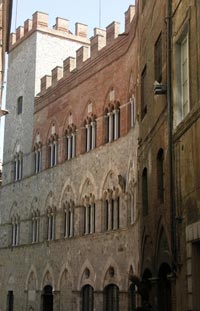 Palazzo Chigi-Saracini |
||
| Palazzo Piccolomini and Pala zzo delle Papesse |
|||
On Via Banchi di Sotto, opposite the former Jesuit convent that today houses the University of Siena, stands the magnificent Palazzo Piccolomini, undisputedly Siena’s finest Renaissance construction, erected by Giacomo and Andrea Piccolomini Todeschini – nephews of Pope Pius II. |
|||
| Palazzo del Magnifico |
|||
Palace Belonging to Pandolfo Petrucci (Via San Giovanni) There is always a bit of confusion when people speak about this palace. In this case, "il Magnifico" (the Magnificent) was not Lorenzo de Medici as those who are not aware of Siena's history generally believe (and quite logically). He was Pandolfo Petrucci, who was as similar to Lorenzo as a saxophone to a guitar. The palace dates from the first decade of the 16th Century and is almost a paradigm of the Renaissance palace and, as such, is worth seeing. In the palace of Pandolfo Petrucci Luca Signorelli worked upon various classic or mythological subjects. |
|||
| Piazza and Palazzo Salimbeni |
|||
| The rectangular Piazza Salimbeni is formed by three buildings and has in its center the statue of the archdeacon Sallustio Bandini. The current square is the result of heavy restoration carried out at the end of the 19th century by the architect Giuseppe Partini, that altered its general image, building on and adding new structures, in the neo-gothic style of the time. The central 14th century Palazzo Salimbeni is the dominant feature of the piazza. At the back of the square, essentially extracted from the garden of the adjacent Palazzo Spannocchi, the ninth century façade (by Partini) of the Palazzo Salimberi stands out. It is one of the most imposing, complex and strengthened fortresses of medieval Siena, and the home of the great Salimbeni family until they were hunted from Siena and their possessions confiscated (in 1419). This imposing building is the headquarters of Monte dei Paschi, one of the Italy's principal banks. Palazzo Salimberi hosts a notable collection of works of art, that is widening thanks to the same Monte dei Paschi: amongst others, there are masterpieces by Sassetta, Pietro Lorenzetti and Beccafumi. To the right of Palazzo Salimbeni is the Palazzo Spannocchi, built in the Renaissance style by the Florentine architect, Giuliano da Maiano in 1470, but completed with the façade in this piazza in 1880 by Giuseppe Partini. Opposite is Palazzo Cantucci. |
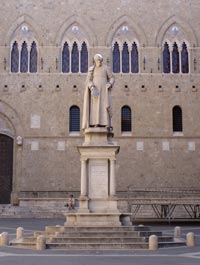 |
||
| Chiesa di Sant’Agostino |
|||
| The Chiesa di Sant’Agostino contains a chapel frescoed by Francesco di Giorgio and Luca Signorelli. These frescoes were discovered beneath an 18th-century plaster redecoration only in 1977. The construction of the Chiesa di Sant’Agostino and its associate convent began in 1258 and lasted for more than fifty years. Other renovations and reconstructions were carried on in the following centuries. The interior, redesigned by Luigi Vanvitelli in the 18th century, has maintained the large high altars in polychrome marble from the 16th-17th centuries. From the Vanvitelli renovation date the stucco statues in the nave and in the transept. The architecture is completed by the rich and interesting decoration [1]consisting of polychrome marble altars and paintings by Pietro Perugino, Francesco Vanni, Rutilio Manetti and Sodoma and by the frescoes by Francesco di Giorgio and Luca Signorelli, within the Bichi Chapel, and the Majestà attributed to Ambrogio Lorenzetti [2] in the Piccolomini Chapel. The Majesty fresco was discovered by chance in 1944 when the Adoration of the Three Kings by Sodoma was moved to save it from the bombardments. |
|||
| Chiesa di San Domenico |
|||
| The Basilica of San Domenico, also known as Basilica Cateriniana, is a basilica church in Siena, and one of the most important in the city. Forever linked to the worship of Saint Catherine of Siena, the Basilica of San Domenico was built at the same time as the domenican convent, between 1225 and 1265, and is fully gothic in its formation. The gothic style manifests itself here in the guant and severe architecture, constructed entirely in brick. The raised chapel off the west end (to the right as you enter) preserves the only genuine Portrait of St. Catherine, painted by her friend and contemporary Andrea Vanni. The Cappella di Santa Caterina (Chapel of St. Catherine) halfway down the right wall was frescoed with scenes from the saint's life. All except the right wall (where in 1593 Francesco Vanni painted Catherine performing an exorcism) were frescoed by Sodoma in 1526. The Chapel, enshrines St. Catherine's incorrupt head and finger in a gilt reliquary case on the altar, wonderful marble altar by the sculptor Giovanni di Stefano (1469). The left wall of the nave has a Madonna with Child by Francesco di Vannuccio, framed by an Eternal with Saint by Il Sodoma and by a predella with fifteen Stories of the New Testament by Antonio Magagna. The right wall has a fresco by Pietro Lorenzetti and the Adoration of the Shepherds by Francesco di Giorgioi. The 15th century marble pavement, featuring Orpheus and animals, is attributed to Francesco di Giorgio. At the end of the nave, on the right, is a Nativity by Francesco di Giorgio Martini dominated by a crumbling Roman triumphal arch in the background and a Pieta above. The first chapel to the right of the altar is home to a Madonna and Child with Saints by Matteo di Giovanni, one of whose masterpieces, Saint Barbara Enthroned with Angels and Saints Mary Magdalen and Catherine, is in the second chapel of the left transept. An altar on the right as you leave has a 14th-century Madonna and Child Surrounded by Four Saints and God by Sodoma, with a 16th -century Siena skyline above the tiny-panelled predella. Sanctuary and House of Saint Caterina | Vicolo del Tiratoio 8 | www.basilicacateriniana.com |
|||
| Fontebranda, a medieval fountain in Siena |
|||
| Fontebranda is one of the medieval fountains of Siena, located in Terzo di Camollia, in the Contrada of Oca, near the Porta of Fontebranda. The fountain was built in the 13th century by the Guild of the Wool-makers (Lana). Fontebranda is the most ancient and impressive fountain of Siena, quoted by Dante in the thirtieth canto of his Inferno. |
 |
||
Fontebranda, a medieval fountain in Siena
|
|||
| The Oratory of the Sanctuary of Saint Catherine in Siena |
|||
 |
|||
Saint Catherine of Siena heals Matteo Cenni, fresco by Vincenzo Tamagni - (Oratory of Saint Catherine in Siena)[2]
|
|||
| The steep descent of Via Santa Caterina leads to the Sanctuary and House of St Catherine, which has become a popular place of pilgrimage. The house of the saint was converted into a sanctuary in 1464 and today contains a number of documents and paintings related to her. The original entrance to the complex was from Vicolo del Tiratoio, through a fine Renaissance door over which was written Sponsae Kristi Chatarinae Domus. In 1941 a new entrance was opened, called the Portico dei Comuni. The entrance opens into the Oratorio del Crocifisso, once the kitchen garden of the Benincasa family and today a single nave church decorated with frescoes by Giuseppe Nicola Nasini.[4] Address
|
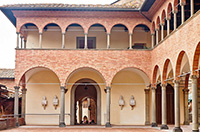 |
||
| San Leonardo al lago |
|||
Between 1360 and 1370 Lippo Vanni executed a cycle of fresco paintings for the church of the rural hermitage of San Leonardo al Lago just outside Siena. Painted on the walls and entrance arch of the chancel of this church, the scheme includes narrative scenes from the life of the Virgin, such as the Presentation of the Virgin in the Temple, the Annunciation, the Betrothal of the Virgin, and the Assumption of the Virgin (over the chancel arch, now badly damaged). Volta del coro di San Leonardo con angeli musicanti dipinta da Lippo Vanni (1360-1370) |
|||
Oratory of Saint Bernardino |
|||
| The figure of the ruler of Siena, Pandolfo Petrucci is linked to one of the most significant religious building, the Basilica dell'Osservanza, founded by San Bernardino and chosen by Pandolfo as his resting place. In the Vestry, planned by him, there are the elegant choir-stalls of carved wood by Antonio Barili and the sculpture in polychrome terracotta moulded by Giacomo Cozzarelli in an intense expressive language supported by a stylish polychromy, a masterpiece of the Sienese late-Renaissance statuary. There are two oratories, placed one above the other, from the XV century; take note of the upper oratory for the frescoes of Sodoma, Girolamo del Pacchia and Beccafiumi. The bottom oratory has decorations by Ventura Salimbeni and Rutilio Manetti. Oratory of Saint Bernardino, Piazza San Francesco 9, 53100 |
|||
| Orto de' Pecci |
|||
| L’Orto de’ Pecci is in the former psychiatric hospital area in Siena and is a green oasis just underneath Piazza del Campo, with a fabulous view of the Torre del Mangia. A dirt path crosses the garden where a co-operative society has maintained it as it always was. To reach this cooperative garden, walk to Piazza del Mercato, then take the stairs leading down to the field of green below. Take the small street which bears to the right of Via Del Sole. A short walk down this road and past the gate, is pleasant and filled with the aroma of lavendar, rosemary and plants of the Tuscan countryside. The view of the Torre del Mangia and of Piazza del Mercato is fabulous from this peaceful spot. The Pecci Garden was built between 1326 and 1420, and is one of the most well preserved green spaces of medieval Siena. Today, the walls enclose green areas between Porta Romana and Porta Pipsini. All'Orto de' Pecci Via di Porta Giustizia 39 Gardens in Tuscany | Ristorante/pizzeria All'Orto de' Pecci | L’Orto de’Pecci Map Other parks and gardens in Siezna include the Orto Botanico or Siena Botanical Gardens and La Lizza, a public garden located in front of the Forte di Santa Barbara, a fortress built by Cosimo I . |
|||
| Santa Maria dei Servi |
|||
| The Basilica Church of Santa Maria dei Servi of Siena is a 13th century church, built on the site of the former San Clement church and annexed to a new convent. The church is notable for its a fine Romanesque bell tower and famous fresco inside. The church stands on the southern end of Piazza Alessandro Manzoni, south-east of the Siena Cathedral and Piazza del Campo. The simple west facade of the church, with a single portal and a rose window, remains unfinished. The Romanesque campanile (13th century) has four orders of windows, increasing in number as they go up in order to enhance the effect of perspective. It was thoroughly restored in the 20th century. Inside is a central nave flanked by two aisles and a number of notable artworks. On the right is the Madonna del Bordone (the Virgin and Child with two Angels) by Coppo di Marcovaldo (1261). In the second chapel in the south transept is the famous Slaughter of the Innocents fresco by Pietro Lorenzetti (c. 1330). The altarpiece is Lippo Memmi's Madonna del Pópolo (c. 1317).
|
|||
|
|
|||
| Grocery shopping in Siena is a great pleasure. Via di Citta, Banchi di Sopra and Via Dei Montanini are three pedestrian streets and a geat shopping area. Lorenzo Rossi is one of Siena's best bakers, and his panforte , ricciarelli and cavallucci are a weekly purchase for most local households. You can try them at his bakery and shop behind the duomo. Rean more on food shopping in Siena |
|||
The Siena area | Tuscany’s Gothic treasures from Chianti to Piancastagnaio
|
||||
Siena is a cultivated, proud Gothic town which welcomes tourists from all over the world with the charm of its past and the wonders of its nature.
|
||||
| The garden of Vicobello |
||||
The garden of Vicobello near Siena was one of the first smaller gardens of the Rennaissance to be created. Redesigned as a country house for the Chigi banking family by the great Sienese architect Baldassare Peruzzi, the house and gardens were constructed between 1528-31 on one of the Chigi farm estates. The coat of arms of the Chigi family is red with gold and six peaks on the highest eight-pointed star with a gold color. The facade of the villa points towards Siena. |
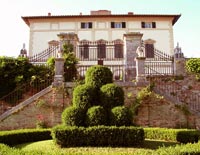 Villa Chigi a Vicobello Villa Chigi a Vicobello |
|||
| Villa Cetinale Gardens in Tuscany | Villa Cetinale |
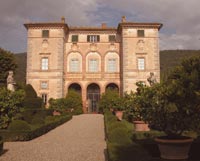 |
|||
Certosa di Pontignano The former monastery of Pontignano, now part of the University of Sienna, is set amongs olive groves, north of Siena. The monastery has three cloister gardens. Two are traditional grass rectangles and one is now a renaissance parterre garden.
|
||||
| Castello delle Quattro Torri This castle dates from the 14th - 15th century. The original structure with the four tall towers, which gave the name to the fortress, is basically unchanged. |
||||
|
||||
| The Chigi family, which later became Chigi Zondadari has very ancient origins. The first to figure in the genealogical tree was Rolando born in the year 1020. The Chigi family was raised to nobility under Lorenzo di Chigio who served on the Concistory in 1377, representing one of the Terzi or Thirds of the City.
Towards the middle of the fifteenth century the Mariano di Agostino branch began to detach itself, predominating in importance since it was led by the patron of the arts Agostino di Mariano, known as “The Magnificent” on account of his exceptional wealth. He was the great banker of the Christian world, and was responsible for the construction of the Palazzo Farnesina in Rome. Among the properties of the Chigi family are the Villa di Vico Bello close to Siena and the Villa delle Volte, in Volte Basse close to Sovicille, set in the depths of the verdant peace of the Sienese countryside, and traditionally used by the family as a site for entertainment and repose. Another figure which brought renown to the Chigi family was Fabio di Flavio, who became Pope as Alexander VII. Born in Siena in 1599, he was a man of culture and an austere ascetic who had a brilliant ecclesiastic career. When he became Pope he transformed Rome with scenic grandiosity, employing the foremost artists of his time such as Maratta and Pietro da Cortona. But it was above all his felicitous collaboration with Gian Lorenzo Bernini which reached levels of sublimity: together, among other works, they created the Colonnade of St. Peter’s in Rome and the Chapel of the Madonna del Voto in Siena. The nephew of this illustrious churchman, Flavio Chigi, was later to become a Cardinal and a great protagonist of the cultural and artistic life of Rome. In spite of this he never forgot Siena and its surroundings. In San Quirico d'Orcia he commissioned from the architect Fontana the palazzo in the centre of the town, an outstanding example of impressive and refined architecture. He left his fortune to his sister Agnese, who was married to Ansano Zondadari, granting to their son, Bonaventura, the title of Marquis of San Quirico. It is to Bonaventura Chigi Zondadari, with the help of the architect Fontana, that we owe the embellishment of Villa di Cetinale, and the establishment of the ceramic manufacture of San Quirico d'Orcia. One of Bonaventura’s brothers, Marcantonio Zondadari, was the Grand Master of the order of the Knights of Malta, another brother Anton Felice, was a Cardinal, while Alexander was archbishop of Siena. The line continued through Bonaventura’s son, Ansano, and the latter’s son Giuseppe Flavio, all men of great culture and human worth, leading up to the birth in 1841 of Bonaventura, Marquis of San Quirico and Senator of the Realm, a great collector and academic. Bonaventura’s son Angiolo died in 1947, and it is his descendants who are now the partners of the RVA group, and owners of the properties managed by the company. The Villa di Vico Bello, with its terraced gardens, and the Vico Alto complex - which after a careful renovation carried out around 1975 has been divided into the flats comprising the Residence Vico Alto – are recorded in the documents of the Chigi family from as far back as before the birth of Pope Alexander VII; they have been handed down from generation to generation to reach the descendants of the family who are alive today. |
||||
|
||||
| Walking in Tuscany | Via Francigena | From Monteriggioni to Siena |
||||
| Although it is difficult to identify a precise route of the Via Francigena, the stretch that crosses the province of Siena is one of the most fascinating sights of artistic and cultural as well as pristine natural areas. In particular, the stretch of the Val d'Elsa, the town of San Gimignano, Poggibonsi, Monteriggioni and Siena were in communication through the Franchigena Street that runs alongside the hills of Chianti then immersed himself in the Crete Senesi. Monteriggioni was originally built by the Republic of Siena for a defensive purpose since the position dominated and watched over the Via Francigena in the direction of Florence, historic rival of Siena. The Via Francigena, ancient road between Rome and Canterbury, was very important during the Middle Ages for merchant and travellers, as well as being the major pilgrimage route. In the stretch between San Gimignano and Siena, the Via Francigena crosses the territory of Monteriggioni, where one of the oldest stopping stations still exists today: the abbey of Abbadia Isola. This 20.5 km leg begins in Monteriggioni and takes in about 6 hours to complete. Leave Monteriggioni and walk along the road in the Sienese hills to the medieval village of Cerbaia. It runs through the woods up to the Castle of Chiocciola and the Castle of Villa, before descending down toward Pian del Lago. Then cross the Renai woods before arriving at Porta Camollia, the traditional Via Francigena entrance to Siena. In the city, walk down Banchi di Sopra and then up to the end of this leg in Piazza del Campo, the Duomo and then the hospital of Santa Maria della Scala.
|
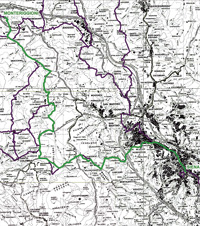 |
|||
PILLOLE QUOTIDIANE DI STORIA SENESE di Maura Martellucci e Roberto Cresti | www.iltesorodisiena.net
|
||||
[3] LE BICCHERNE DI SIENA. Arte e finanza all'alba dell'economia moderna. (SIENA'S BICCHERNA COVERS. Art and finance at the dawn of the modern economy)
|
||||
|
||||
| Podere anta Pia, garden view in April | Podere Santa Pia | Monte Cucco wine region | ||
 |
||||
One of the best places to slow travel in southern Tuscany is Podere Santa Pia. This holiday house is a peaceful retreat, perfect for relaxing with magnificent panoramic views of the mystical Maremma hills up to the Mediterranean Sea and Montecristo.
|
||||
| Tuscany | Siena Surroundings Art in Tuscany | Sienese School of Painting |
||||



